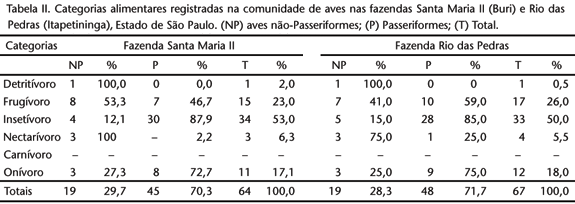Qualitative and quantitative survey of bird community were performed in two distinct semideciduous forest in the interior of the State of São Paulo from July 2004 to July 2005. Point Counts were used for the quantitative survey followed by diversity and frequence of ocurrence indexes of the bird assemblage. The qualitative survey registered a total of 181 species of birds at Fazenda Rio das Pedras (FRP, Itapetininga, 350 ha) and 126 at Fazenda Santa Maria II (FSM II, Buri, 260 ha). The qualitative survey registered 73 species in 998 contacts and 64 species en 1019 contacts, respectively, for FRP and FSM II. The ponctual index of abundance (IPA) varied from 0.01 (one contact) to 1.32 (132 contacts) at FRP and from 0.01 (one contact) to 0.97 (97 contacts) at FSM II. The general diversity index for FRP was H’ = 2.85 and H’ = 3.04 at FSM II. Both areas presented an evenness index of E = 0.91. The bird community in both patched of forest showed the same pattern found in other different forest fragments of relative size studies by many distinct authors. In both localities, insectivorus (53% at FSM e 50% at FRP) and frugivorus (23% na FSM e 26% na FRP) birds were the most representative. Among the former, Tyrannidae and Thamnophilidae were predominant, respectively, at FSM and FRP. In both places understory insectivorous birds were dominant (53% at FSM and 51,4% at FRP), followed by understory frugivorus at FSM (50%) and by canopy frugivorus (52,6%) at FRP. The importance of bird community in forest remmants in linked to managing and conservation of wild natural forested in Stade of São Paulo.
Bird structure; forest remmants; trophic structure






